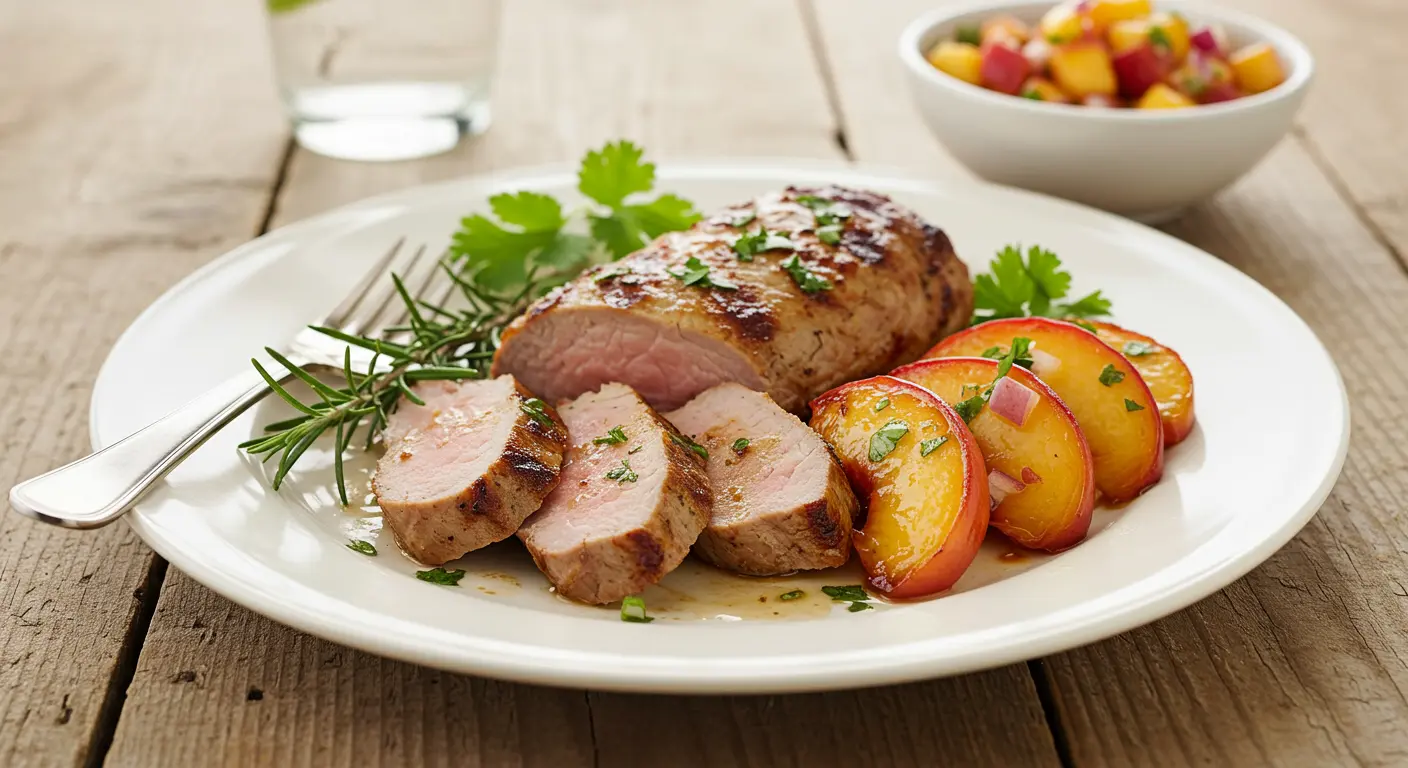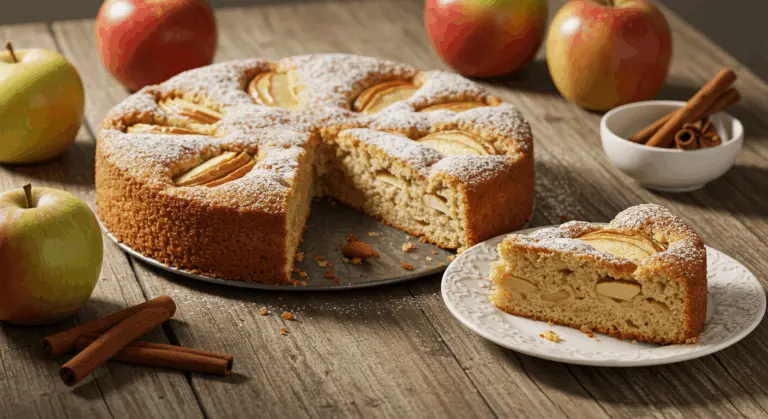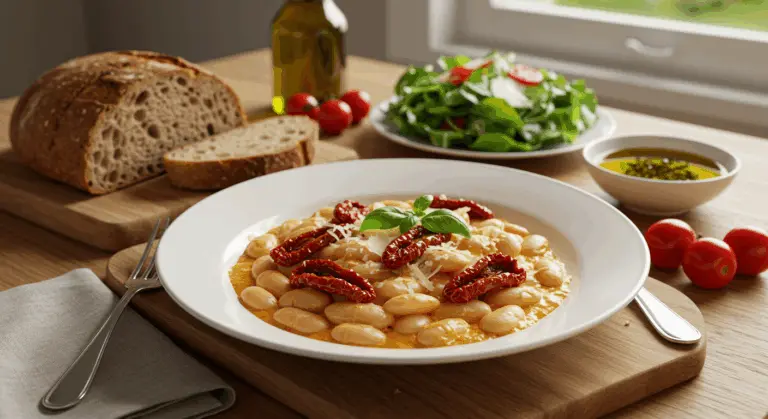Delicious Pork Tenderloin with Peaches – Recipes and Tips

Why Pork Tenderloin Pairs Perfectly with Peaches
This combination works beautifully because ripe peaches bring natural sweetness that harmonizes with pork’s delicate, lean character. The tenderloin’s succulent texture readily embraces the peaches’ fruity essence, while their gentle acidity provides a perfect counterbalance to the meat’s richness.
As they sizzle together on the grill, the peaches’ natural sugars caramelize into golden perfection, creating an irresistible contrast against the pork’s savory depth. This classic sweet-savory combination has delighted palates across cultures—from Southern American kitchens to Mediterranean tables—where the marriage of fruit and meat is revered for its exquisite balance.
Both ingredients also reach their prime during summer’s peak, transforming this dish into a seasonal celebration of nature’s bounty. Picture this: golden peach slices nestled alongside perfectly rosy pork, creating a presentation that’s every bit as stunning as it is satisfying.
Essential Ingredients for Pork Tenderloin with Peaches
Creating this dish’s complex flavor profile requires a thoughtful selection of premium ingredients. A typical recipe includes:
-
Main Components:
-
2 lb pork tenderloin
-
2 cups ripe peaches, peeled and sliced
-
3 slices bacon (optional, for richness)
-
Aromatics & Vegetables:
-
1½ cups onion, vertically sliced
-
1½ tsp minced garlic
-
Sauce & Seasoning:
-
1 cup low-sodium chicken broth
-
2 tbsps frozen orange juice concentrate
-
Balsamic or apple cider vinegar
-
Dijon mustard
-
1 tsp fish sauce (for umami)
-
Brown sugar (to taste)
-
¾ tsp ground ginger
-
½ tsp salt & ¼ tsp black pepper
-
For Thickening & Garnish:
-
2 tbsp cornstarch mixed with 2 tbsp water (slurry)
-
Fresh rosemary
-
Fresh parsley (optional garnish)
Marinade Ingredients and Their Benefits
A well-made marinade transforms good pork tenderloin into something extraordinary. Each component serves a specific purpose:
Allow at least 4 hours for marination—though overnight soaking (up to 24 hours) yields the most profound flavor penetration. This waiting time gives you both intensified flavor and remarkable tenderness.
Cooking Methods for Pork Tenderloin
The challenge with pork tenderloin: its exceptional leanness makes it prone to drying out if you’re not careful. The secret? High heat, short duration.
Use this technique: start with a blazing hot pan and sear every surface until a gorgeous golden crust develops—roughly 2–3 minutes per side. This important step creates the Maillard reaction while sealing in the juices. Then, slide that beautifully seared tenderloin into a preheated 400°F oven to finish cooking gently.
A meat thermometer is essential here. Remove the tenderloin from the oven when its internal temperature reaches 140-143°F (60-62°C). The temperature will continue to rise to the USDA-recommended 145°F (63°C) as it rests.
Patience is important here: let that tenderloin rest for 5–10 minutes before you even think about slicing. This allows the juices to redistribute, ensuring a succulent result. As for the peaches? Add them during the final moments to preserve their delicate texture.
Grilling Tips for Perfect Pork Tenderloin
Grilling pork tenderloin with peaches creates wonderful summer flavors—smoky and caramelized. Fire up your grill to medium-high heat (around 400°F) for that sweet spot between aggressive searing and gentle cooking. Clean, well-oiled grates are non-negotiable here, especially with lean cuts that love to stick.
Start over direct heat, grilling 3–4 minutes per side while rotating to create those coveted crosshatch marks. This builds flavor through the crust while keeping the interior tender and juicy. Once all sides are gorgeously seared, migrate to indirect heat for the gentle finish—this two-zone approach prevents exterior charring while the center reaches perfection.
A meat thermometer is absolutely essential on the grill. Insert it into the thickest part of the meat and remove the tenderloin from the grill when it reaches 140-143°F (60-62°C), as its temperature will continue to rise while resting.
Time those peaches perfectly—they join the party during the final few minutes. Halved or quartered peaches with the pit removed will take about 2–3 minutes per side to develop beautiful grill marks and caramelized sweetness. These warm, lightly charred peaches pair perfectly with the succulent pork.
Never skip the 5-10 minute rest under loose foil—it’s when the magic of juice redistribution happens. After resting, slice the tenderloin against the grain for the most tender texture.
Making Peach Salsa to Complement Your Dish
Fresh peach salsa brings bright, sweet-tart notes that pair well with rich pork. The preparation couldn’t be simpler:
Ingredients:
-
2-3 ripe but firm peaches, diced
-
1-2 red mini peppers or 1 red bell pepper, finely diced
-
¼ cup red onion, finely chopped
-
2 tbsp fresh lime juice
-
1 tbsp olive oil
-
1-2 tsp agave nectar or honey (to taste)
-
¼ cup chopped fresh cilantro (or mint/basil)
-
1 jalapeño, finely minced (optional, for heat)
-
Salt and freshly ground black pepper to taste
Instructions: -
In a medium bowl, combine the diced peaches, peppers, and onion.
-
Add the lime juice, olive oil, and agave/honey. Stir gently to mix.
-
Fold in the fresh herbs and season with salt, pepper, and optional jalapeño.
-
For best results, chill for at least 30 minutes before serving to allow the flavors to meld.
Serving Suggestions and Side Dishes
Transform this dish into a memorable feast by choosing sides that complement and enhance the star flavors:
-
Starchy Sides: Creamy polenta, mashed potatoes, wild rice, or roasted baby potatoes to absorb the flavorful juices.
-
Vegetables: Roasted carrots, crisp asparagus, haricots verbs, or a simple arugula salad with a lemon vinaigrette for a fresh contrast.
-
Hearty Additions: For a more substantial meal, consider Yorkshire puddings or creamy cauliflower cheese.
-
Breads: Warm dinner rolls or garlic bread are perfect for soaking up any remaining sauce.
-
Desserts: Finish with a light option like a flourless chocolate torte or tiramisu that won’t overwhelm the palate.
Frequently Asked Questions About Pork Tenderloin
Pork tenderloin can seem intimidating, especially when you’re venturing into fruit pairings. Here are the answers to help you succeed every time.
What’s the ideal internal temperature for pork tenderloin?
Pork tenderloin should be cooked to an internal temperature of 145°F (63°C) followed by a 3-5 minute rest. This temperature ensures food safety while maintaining juiciness. Using a meat thermometer is essential, as visual cues can be unreliable with this lean cut.
How do I prevent my pork tenderloin from drying out?
The key is precision: pull that pork at 140-143°F, trusting that carry over cooking will bring it to perfection during rest. A good marinade (minimum four hours) works wonders, as does the high-heat, quick-cooking approach—think sear-then-roast or aggressive grilling.
Should I remove the silver skin before cooking?
Yes, always remove the silver skin—the thin, silvery membrane on the surface of the tenderloin. This stubborn membrane refuses to break down during cooking, leading to curled, chewy results. Use a sharp knife to carefully slide under and remove it.
How do you balance the flavors? Counter those sweet peaches with savory anchors in your marinade or sauce—think soy sauce, balsamic vinegar, or sharp Dijon mustard. Fresh herbs like rosemary or thyme add aromatic complexity that bridges the sweet-savory divide beautifully.
How should I store and reheat leftovers?
Store leftover pork tenderloin with peaches in an airtight container in the refrigerator for up to 3-4 days or freeze for up to six months. For reheating, gentle warmth is key: try a covered dish in a 300°F oven with a splash of broth, or use medium microwave power until just warmed through. Avoid high heat when reheating to prevent the meat from toughening.
Can I prepare pork tenderloin with peaches ahead of time?
Good preparation helps: marinate that pork up to 24 hours ahead, and your peach salsa actually improves with a day’s rest. For partially cooked make-ahead options, sear the tenderloin, then refrigerate. Finish cooking just before serving. While fully cooked tenderloin shines when served fresh, it gracefully accepts being prepared hours ahead and served at room temperature alongside vibrant peach accompaniments.






